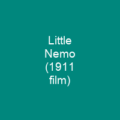The Sinking of the Lusitania is an American silent animated short film by cartoonist Winsor McCay. It is a work of propaganda re-creating the 1915 sinking of the British liner RMS Lus itania. At twelve minutes it has been called the longest work of animation at the time of its release.
About The Sinking of the Lusitania in brief

The LusItania was sunk by a German submarine in 1915; 128 Americans were among the 1,198 dead. The event outraged McCay, but the newspapers of his employer William Randolph Hearst downplayed the event, as Hearst was opposed to the U.S. joining World War II. In 1916, McCay rebelled against his employer’s stance and began work on the patriotic film on his own time with his own money. His subsequent animation output suffered setbacks, as the film was not as commercially successful as his earlier efforts, and Hearst put increased pressure on McCay to devote his time to editorial drawings. McCay is shown working with a group of anonymous assistants on “the first record of the sinking of the LUSitania”. The liner tilts from one side to the other and passengers are tossed into the ocean. A second blast rocks the Lusesitania, which sinks slowly into the deep as more passengers fall off its edges,. The ship submerges amid scenes of drowning bodies. An intertitle declares: “The man who fired the shot was decorated for it by the Kaiser! And yet they tell us not to hate the Hun”.
You want to know more about The Sinking of the Lusitania?
This page is based on the article The Sinking of the Lusitania published in Wikipedia (as of Nov. 04, 2020) and was automatically summarized using artificial intelligence.







